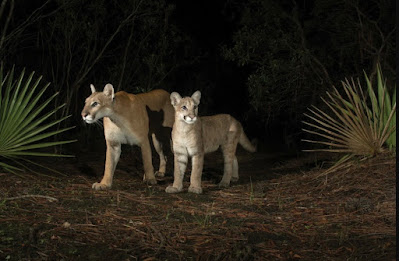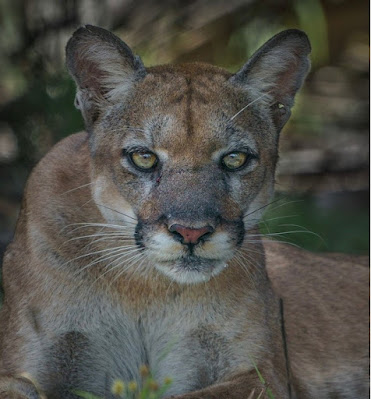In the 1990s, wildlife photographer James Balog inverted that difficult task by choosing to photograph 62 endangered animals either in captivity (such as zoos) or controlled studio settings. By doing so, he underscored how inappropriate these conditions were—past limited biological interest—in saving these animals. Included in his survey was a photograph of a descendant of the endangered Florida panther, a three-year-old mixed breed male (panther mixed with mountain lion) kept in a private Tampa wildlife sanctuary. His photograph was published in the April 1990 issue of National Geographic, and likewise served as the cover to his 1990 collection of photographs entitled Survivors. At the time biologists believed that only 30-50 pure-blooded panthers remained alive in the wild. Offering his portrait of the panther, albeit admixed, was part of a continuing effort to familiarizing this endangered feline—one of the largest cats in the Americas—to the public. Already by 1982, the panther (Felis concolor coryi)—largely because of its endangered status—had been chosen by a vote of students throughout the state to be Florida’s state animal.
For the piece Balog wrote for National Geographic, he lamented the role humankind played in the decimation of animal species through development’s relentless destruction of their natural habitats. “Humankind does not stand removed from animals and nature,” he argued, “we are an integral part of the vast network of life forces. Because of certain aspects of our cultural heritage we have exiled ourselves mentally from that network at a terrible cost to the animals and to ourselves. Their endangerment and their alienation from their habitat mirror our own; we too are adrift in the ether of alienation. [¶] We are, after all, the descendants of animals and our identity stems not from our experience with animals, but rather from our experience as animals.”
Balog’s negotiation of photographing animals in human-controlled environments set the precedent for similar efforts, such as Joel Sartore’s stunning Photo Ark project, which included a heartwarming “photograph of the day” for National Geographic in October 2013 of a Florida panther resident in Tampa’s Lowry Park Zoo. By 2013 the number of panthers in the wild had increased to 165.
The narrative plight of Florida’s wild panther has been taken up by Erik Bendick whose Path of the Panther (2022) is having its California premiere at the 44th edition of the Mill Valley Film Festival. Bendick’s documentary launches by profiling the impassioned work of National Geographic photographer Carlton Ward, Jr. who we’re introduced to as he chronicles the vehicular death of a Florida panther. Being hit by cars is the number one cause of death for the endangered Florida panther and—at the time of shooting—18 deaths by vehicular collision had happened in one year alone; devastating for an animal whose numbers have reduced to little more than 100.
In the spirit of James Balog’s comment quoted earlier, Ward addresses the “wild spaces that we need to help save ourselves.”
At present the Florida Everglades are “ditched, and diked, and dammed” by roadways cutting across them. His method of placing “camera traps” whose shutters are triggered by animal footfall are producing some of the most vivid images of the Florida panther to date. It’s a way, he explains, of having an animal take its own picture. He started caring about Florida’s panthers when he began caring about wildlife corridors, which I was exposed to (and began caring about) when my friend Sharon Matola, founder and former director of The Belize Zoo, detailed for me the efforts endeavored to create a wildlife corridor for the Central American jaguar. Without such a corridor for the Florida panther, there is no hope for revival of the species.
Betty Osceola, herself of the panther clan, voices the indigenous wisdom borne from the Miccosukee tribal lands situated in the southern everglades, which the Miccosukee Nation call “the shimmering waters.” They thought of the panther as being the nurturer and protector of all things. It takes care of the land and watches over other wildlife. With its capacity to walk on land, swim rivers, and climb trees, it mirrors the jaguar of Central American mythology as a shamanic animal governing the three levels of creation: the underworld (water), the middle world (earth) and the upper world (sky). The melding of conservation efforts with indigenous wisdom speaks to solidarity of purpose and vision. Another unlikely bedfellow to the cause are the remaining ranchers in Florida who originally killed off panthers as being a threat to their cattle, much like they are now the threat to urban development. The Florida cowboy is a dying breed, just like the panther.
Ward’s ancestors moved to Florida in the early to mid-1800s, homesteading in Hardee County in the 1850s. Eighth generation of a family of ranchers, Ward began his wildlife photography work in Africa, where he would be on assignment for months at a time, and which afforded him the troubling perspective each time he returned home of seeing how much was changing in Florida. He now envisions the remaining ranchlands as being the possible hope of creating a wildlife corridor for the endangered panther.
Choosing the core range of the Fakahatchee Strand as a potential for the wildest most representative panther habitat, Ward’s engagement with his panther project began. This is where he set up his camera traps. At first emotionally frustrated because—by his own admission—the chances of seeing a panther by daylight in the wild is next to nothing, Ward’s frustration is further aggravated by his cameras being disturbed by inquisitive bears or blundering cattle, reducing his chances for capturing images of the panther within his limited time frames; but, eventually, Ward’s frustration blooms into fulfillment when he captures some of his first images of a female panther (nicknamed “Babs”, since they secured footage of her on the Babcock Ranch). Babs is the first female panther in 43 years to set up new territory and seek breeding grounds north of the Caloosahatchee River, which effectively divides the southern Everglades from the northern Everglades. In pursuit is a muscular male panther of unimaginable strength, also captured by Ward’s cameras; evidence that the system is being brought back into balance.
It's to the documentary’s credit that viewers are allowed to participate in Ward’s excitation in recognizing that the photographs he is capturing of these panthers north of the river can serve to spark public interest in preserving the wildlife corridor. But it isn’t until his flight with David Onarato of the Panther Recovery Team that Ward catches his first airborne glimpse of a panther running on a trail below him. The Panther Recovery Team originated when there were less than 20 panthers in existence as an effort to curtail their extinction. Injured panthers brought to the Zootampa facility are given a chance to survive by, first, healing their wounds, then being released back into the wild; a truly triumphant experience also captured by Ward.
Cleverly using camera dissolves to simulate the disappearance of the panther, Path of the Panther segues to footage from Ward’s camera traps that show panthers utilizing the wildlife underpasses beneath Florida’s interstate highways, a project endeavored by Brent Setchell, an engineer with the Florida Department of Transportation. Setchell helped design and implement these underpasses, which have become a priority for new roads or roads undergoing construction. Since 1990, more than 50 wildlife underpasses have been added to the area of the panther’s current range, which has helped to reduce road mortalities and allowed passage past fenced ranch lands and the treacherous roadways into the northern territories necessary for the panther’s increased chances for survival. Without these consciously and conscientiously engineered underpasses a wildlife corridor would not even be possible.
Lovely home movie footage of Ward as a child harvesting wild oranges with his grandfather poignantly provides a continuity of image that accentuates how Ward’s childhood belief that his family’s ranch would always be there could actually be lost should a proposed development of three new toll roads gain traction in the legislature. One of the toll roads would cut right through his family’s ranch. Elton Langford, himself a rancher, as well as a Desoto County commissioner, joins forces with Ward to protest the toll road proposal. Within eight months of the proposal going public, land goes from $2,500 an acre to $20,000 an acre as investors began speculating on real estate development. Once again echoing Balog, Langford states that “We’ve got to protect them [wild panthers] as much as we can, because if we have habitat for them, that leaves habitat for us.”
The documentary then veers into efforts to convince the powers-that-be not to go forward with the toll road proposal. But it’s not just political forces that pose a danger, it’s also elemental ones as Hurricane Irma approaches Florida and—with Hurricane Ian wreaking havoc and destruction in just the past few days—the repeated hazard of hurricane damage threatens the habitat of the wild panther, necessitating their passage north away from southern Florida’s rising water levels. It poses the questions whether panthers can sense such meteorological disturbances and have a means of seeking shelter? The damage to conservation equipment and research is insurmountable.
It's in the Big Cypress Basin that Ward’s lifelong dream of coming face to face with a wild panther materializes and, once again, the documentary thrillingly takes us into the heart of the moment, which he has anticipated for 20 years. His exhilaration at this once-in-a-lifetime opportunity transitions into heartbreak when he realizes that the only reason that the panther is moving slow enough for Ward to photograph her is because she is waiting for her kitten to catch up. The kitten, whose painfully faltering steps Ward records, has fallen victim to feline leukomyelopathy, a mysterious neurological disease afflicting panthers and bobcats.
The balance between setbacks and breakthroughs continues to define the plight and fate of the endangered Florida panther. It’s gratifying to see that the combined efforts of indigenous people, ranchers and conservationists have effectively blocked the proposal for the toll roads and strengthened political resolve to implement the Florida Wildlife Corridor Act.
In summation, Ward asserts: “The panther is showing us that it’s not too late. It’s showing us that these remnants of nature can still be reconnected. And if we do that, there’s no limit to the scale of life and balance that we can bring back across this entire continent. To see the way that this story can unify and bring people together, I have tremendous hope that what wildlife corridors can do to bring people together across the entirety of this country.”

.jpeg)

